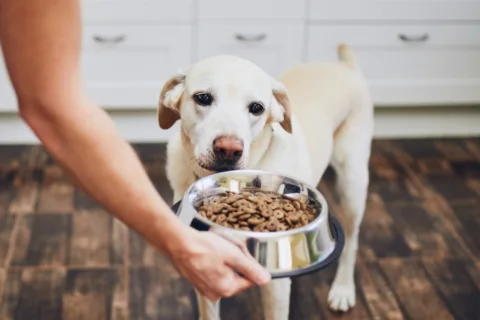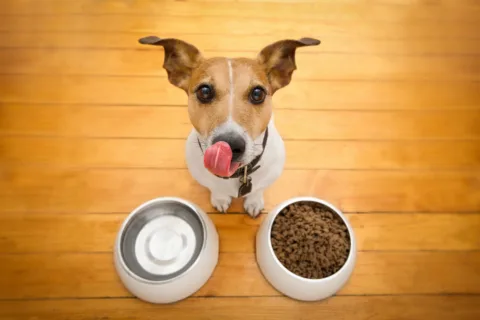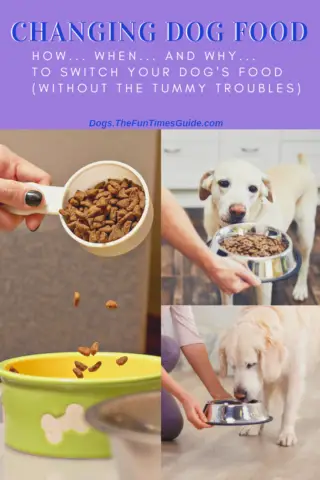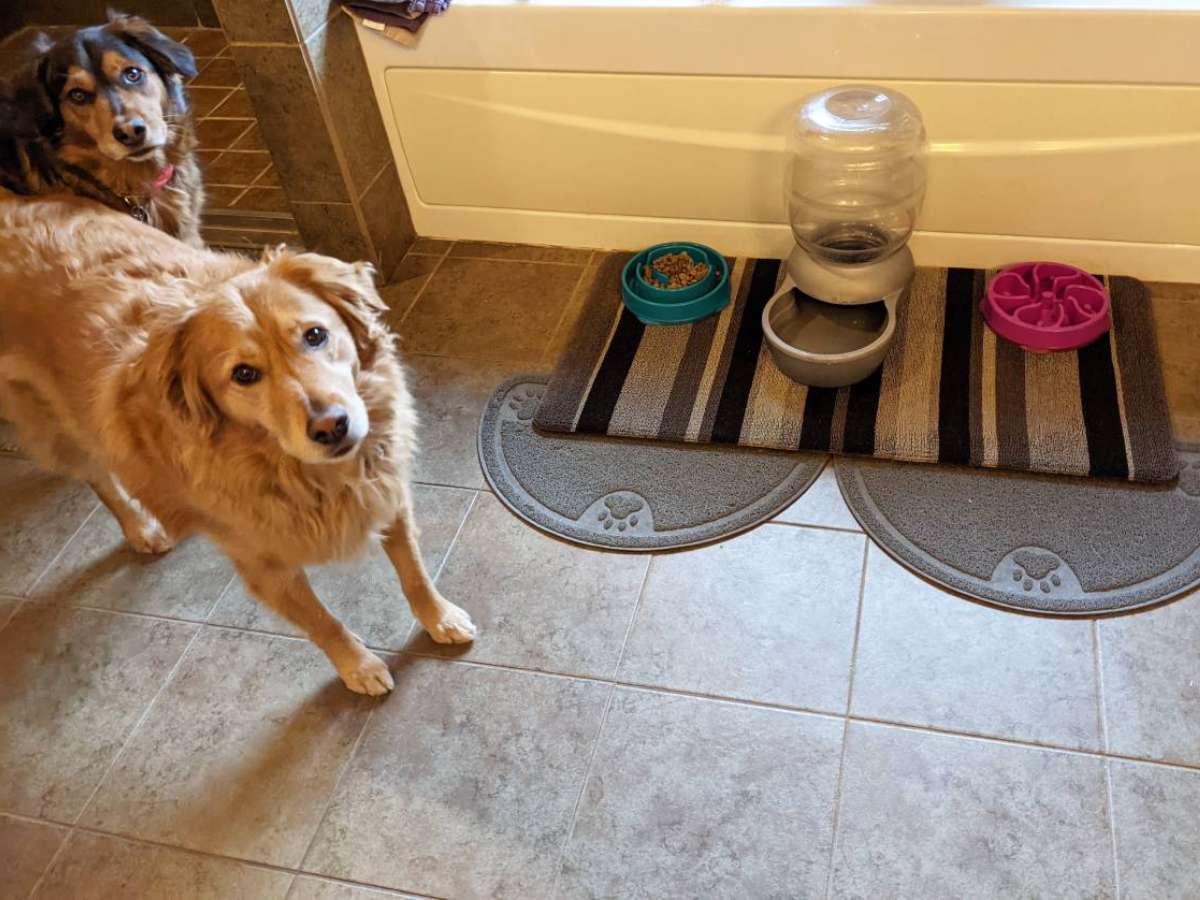Switching your dog to a new food will need to happen at least twice in their life — as they transition from puppy to adult and then from adult to senior, because their nutritional needs will change.
But life-stage transition isn’t the only reason your pup’s diet may need to be re-evaluated and adjusted.
If your dog develops health concerns, you’ll want to make sure their diet is formulated to address the cause and manage the symptoms.
These are the most common reasons for switching your dog’s food:
- Food Allergy and Intolerance – If your pup is reacting to their current food (diarrhea, vomiting, gas, loss of appetite, unhealthy weight gain or loss, itching), you’ll want to identify the foods they’re sensitive to and eliminate them from your dog’s diet.
- Weight Management – If your dog’s current food is causing weight gain or loss, the calories per serving will need to be adjusted to support your pups specific activity level, health, age, or physical condition.
- Age – If your dog is transitioning from one life stage to the next (from puppy to adult or adult to senior), their dietary needs will change too.
- Health Concerns – If your dog is suffering from a disease or condition that requires nutritional support: kidney disease, bladder stones, recurrent urinary tract infections, liver disease, obesity, arthritis, skin issues, chronic gastrointestinal issues, heart disease.
- Variety – If switching dog food isn’t absolutely necessary, then it’s best not to. Dogs don’t seek variety in their diets the way people do.
Despite being a change for the good, switching dog food can be an uncomfortable process for your pup.
Fortunately, there are ways to reduce the stress and side effects and help your dog transition to a new food smoothly…
How To Switch Dog Food
When you’re ready to switch your dog to a new food, do it gradually to help avoid an upset stomach, diarrhea, vomiting, constipation, food refusal, uncomfortable gas, and bloating. And keep a close eye on your dog’s poop — this is one of the best ways to know how well they are adjusting.
I recommend using a gradual 5-day schedule. But if your dog has diarrhea or loose poop for a prolonged period, then you’ll need to slow it down further.
A good approach is to increase the amount of new food by 20% every day, while decreasing their old food. The 5-day schedule would look like this:
- Day 1: 20% new food, 80% old brand
- Day 2: 40% new food, 60% old brand
- Day 3: 60% new food, 40% old brand
- Day 4: 80% new food, 20% old brand
- Day 5: 100% new food
Why is my dog having so much difficulty adjusting?
Generally, when a pet parent comes to me with concerns after changing dog food, it’s because their dog is experiencing gas and loose stool for longer than they expected.
The reason for this is because bacteria and other microbes in the gut are accustomed to digesting certain foods — it takes time for the gastrointestinal system to learn how to handle the new food.
Slowing down the process is the best approach if your pup is having tummy issues.
If it persists, you may need to put your pup on a temporary fast (for 12 to 24 hours) to help their digestive system reset. You can follow this with smaller meals until they adjust.
What if my dog refuses to eat?
If your dog doesn’t really like change, then you’ll need to introduce the new food in tiny amounts so that it becomes familiar over time. This is doubly true if the change is significant — such as transitioning from wet food to dry kibble or from one protein to another.
If your pup is resisting the change, you’ll want to try doubling the 5-day approach by spending 2 days at each stage.
Here are 2 tricks to coax resistant eaters:
- Offer your dog a few kibbles or bites of canned food by hand. Food seems more “special” when offered with affection.
- Lightly moisten kibbles or add a little warm water to canned food to enhance aroma and texture.
What about going cold turkey?
Your dog might be just fine with sudden change. But since it’s often hard to tell what is or isn’t causing them distress, I recommend easing them into the new food gradually.
What if my dog has a severe reaction?
It’s very rare that dogs develop more severe signs of distress when switching dog food. But if it happens, take away all food and call your veterinarian. (For example, other factors in your dog’s life could cause vomiting).
Often, this type of tummy distress when changing dog food will resolve itself in about 12 hours. When you and your pup are ready, start the transition again and slow down the pace.
Here are a few more tips:
- Dogs with kidney issues may take longer than others to transition to a new food. Go slow and keep a close eye on their progress.
- Be sure to read the label on your dog’s new food — especially if you’re switching formulas. The ingredients and calories per serving can vary widely.
- If your dog experiences diarrhea for more than 2 days, you’ll need to adjust your approach. Prolonged diarrhea can cause dehydration quickly.
When To Switch Dog Food To Support The Stages Of Your Dog’s Life
Puppies, adult dogs, and senior dogs have very different nutritional requirements.
Even dogs of the same age can have entirely different needs!
It’s crucial to choose a food that’s formulated specifically for your dog’s needs.
TRANSITIONING A PUPPY TO ADULT FOOD
When to Switch to Adult Dog Food
I often get the question, “When should I stop feeding my dog puppy food?”
The answer to this really depends on the breed of your dog — because their size is a significant factor.
Generally speaking, here are the ages (by size) marking adulthood in dogs:
- Small breed dogs become adults as early as 8 months of age
- Medium size dogs enter adulthood around 1 year old
- Large breed pups won’t reach adulthood until 18 to 24 months
How to Find the Right Food for Your Size Pup
Not every dog has the same nutritional needs.
For instance:
- Large breed dogs need a diet low in calcium and phosphorus to avoid abnormal skeletal development.
- Small breed dogs generally require a more calorically-dense food to support their very high metabolism.
So when you decide to transition your puppy to adult food, consider talking to your vet or a pet nutritionist for some guidance.
Switching to Adult Food Too Soon
I don’t recommend feeding your puppy a diet that’s designed for adult dogs. I know it gets tricky when there are multiple dogs (at different life stages) in the same house. But it’s worth the effort to keep your puppy eating puppy food until they’re finished growing.
Puppy food is packed with the high calories and nutrients their growing body needs. So don’t switch them too early — because it could create problems for them as they age.
And the reverse is also true. Once your dog is out of the puppy stage, you’ll want to switch their food to adult food to avoid weight gain. While that chubby puppy belly may look cute, being overweight can cause a host of long-term problems — bone and joint issues in particular.
An Exception to the Rule: If your dog is pregnant or nursing, feeding them puppy food can help provide the extra nutrients and energy that she and her pups need.
TRANSITIONING AN ADULT DOG TO SENIOR FOOD
When to Switch to Senior Dog Food
Unless your pup is one of the smaller breeds like a Boston Terrier or a giant breed like an English Mastiff, you can expect your dog to enter their senior years around 7 or 8. (For smaller breeds, it’s around 10 or 12. Larger breeds reach senior age as early as 5 or 6.)
So making adjustments to their diet, and transitioning from an adult to senior dog food actually depends on your dog’s size and breed.
Age Isn’t the Only Consideration
I’ve had pet parents come to me with dogs who are technically considered senior but without significant signs of aging. In cases like this, it’s not necessary to switch your dog to a senior food simply based on their age.
But if your dog is beginning to experience some of the following symptoms associated with aging, then a dietary adjustment should be considered:
- Arthritis
- Joint Pain and Stiffness
- Diabetes
- Cancer
- Dental Problems
- Heart Disease
- Kidney Disease
- Weight Gain or Loss
As your dog ages, their health and stamina will slowly decline, and their metabolism might slow down. So switching to a senior dog diet with the proper nutrients and fewer calories (if appropriate) will help keep them at their healthiest weight.
The Bottom Line
Just remember, every dog responds differently to a change in diet — some pups may breeze through it, others may need up to 3 weeks of gradually introducing the new food.
As long as you are patient and prepared to make adjustments, your pup will make it through the transition and be healthier for it.
Dr. Laura Duclos leads the Research and Development team at Puppo. She has over 16 years of experience in developing nutritional pet food that supports animal health and wellbeing. Her clinical research has been featured in prominent publications and scientific journals. She has been an invited speaker at numerous international veterinary conferences on pet nutrition and innovation.
Like this post? Save it to read again later… or share with others on Pinterest!












